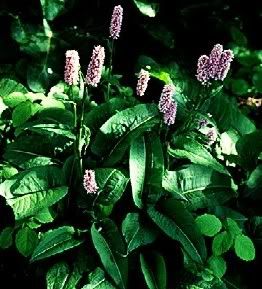

Bistort (Polygonum bistorta)
Folk Names: Adderwort, Columbrina, Dracunculus, Dragonwort, Easter Giant, Easter Ledges, Easter Mangiant, English Serpentary, Oderwort, Osterick, Passions, Patience Dock, Red Long, Serpentaria, Serpentary Dragonwort, Snakeweed, Sweet Dock, Twice Writhen; possibly synonymous with "lost" herbs Oxylanathum Britannicum and Limonium
Description: Bistort is a European mountain perennial, preferring damp soil. It has been naturalized to the United States and Nova Scotia. Bistorta, meaning "twice twisted," acquired its name from the thick and knobby rhizome root, which twists into an S or double S shape. It can grow as long as three feet. It is black outside and red inside and ringed with old leaf scars. Leaves are blue-green with long petioles. Basal leaves are oblong-lanceolate. A slender, simple, glabrous stem reaches up to thirty inches. The few leaves on the stem diminish in size the higher they go. They are lanceolate to linear, and short-petioled to sessile with a dry leaf sheath at their base. The stem is topped by white or red to rose flowers growing from a dense, spike like raceme from May to October. The fruits are three-sided while the seeds are small, brown, and shiny.
Effects: gentle
Planet: Saturn
Element: earth
Associated Deities:
Traditions:
Bistort was once traditionally eaten at Easter (Eostara) in northern England, the name mangeant meaning herb eaten at Easter.
The plant corresponds to the rune nyd or nauthiz.
Magic:
The leaves were once steeped in wine to hinder miscarriages. It is assumed they were strained from the wine, and the wine was drunk. Pieces of the plant were carried to conceive.
An infusion of bistort can be sprinkled about an area to drive out poltergeists and other spirits.
It has been used in money and wealth incense or sachets.
Known Combinations:
Combined in incense with Frankincense, this mixture is used to improve powers during divination.
Medical Indications: Parts Used : root (gathered in March when the leave first appear and dried; it has an astringent, starchy taste, but no odor)
Bistort is primarily an astringent and diuretic. It has been used as a remedy for diarrhea, even bloody or bacterial dysentery. It is possible that it came to be used as a remedy for miscarriage do to its astringent ability to stop bleeding. It has also been used for heavy menstrual bleeding. In Shakespeare's day, the juice was snorted for nasal polyps, and the root was boiled in wine for diarrhea and dysentery. It was also a remedy for vomiting and to tighten loose teeth. A decoction may be prepared for a mouthwash for gum problems and inflammations of the mouth. As an external wash or poultice, or as an additive to lotion, it may be applied to sores and hemorrhages. Powdered root will stop bleeding.
Nutrition:
The rhizome of bistort was used as a famine food in Russia, Siberia, and Iceland due to its high starch content. It was usually soaked in water and roasted, then added to soup or ground to flour. The young leaves were also cooked like spinach in Lancashire and Cumberland.
In the north of England, it is an ingredient of "Bistort-pudding" or "Herb-pudding." Take a half pound of bistort shoots and a pound of nettles. Add a few leaves of black currant, yellow dock, and a sprig of parsley. Wash thoroughly, adding salt to the water of the last washing. Chop all ingredients finely, and place them in a bowl with about a cup full of oatmeal and salt and pepper to taste. You may also choose to add some chives. Boil in a bag for about two and a half hours. Add a lump of butter and a beaten egg before eating. (The heat of the pudding is sufficient to cook the egg.
Mercantile Uses:
The root is a rich source of tannic and gallic acids which enable it to be used in tanning leather when gathered in sufficient quantity. Birds like the seeds, which have been employ in fattening fowl. When not put to use medicinally, in livestock feed, in the garden, or for tanning, it is usually seen as little more than an obnoxious weed. Attempts to eradicate it usually make it thrive, while it may simply die of neglect if left completely untouched.